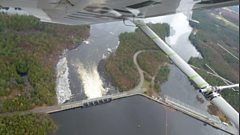Freshwater Eels and Mitten Crabs
Brett Westwood looks at the invasive Chinese mitten crab, plus challenges faced by both American and European freshwater eels.
The American eel is a freshwater eel that spawns in the Sargasso Sea in the Atlantic Ocean, and travels as larvae along the North Atlantic coast to the mouth of American and Canadian rivers before travelling upriver as glass eels to mature in the river over 20-40 years. Then as a silver eel; its adult form, it migrates back down the rivers to return to the Sargasso Sea to start the cycle of life all over again. The Ottawa River in Canada is a very important river for eels as it produces a large number of female eels, so it is essential these adult female eels can get out successfully to the sea. Many hydropower dams for producing electricity on the Ottawa river prevent the eels migrating successfully as adult eels can be killed when they try and pass through the turbines. On this particular river, eel populations have suffered severe declines. New technology and design and suitable passes are helping to increase the chance of eels getting past the dam turbines.
Like the American eel, the adult European eel travels 4000 miles to spawn in the Sargasso Sea and journeys to and from UK rivers to complete its lifecycle. It also faces problems on UK rivers due to sluices, flood defences and other barriers to migration. In Europe, eel populations have also been declining and since 2007 they have been the subject of a European regulation which means that member countries have to put in place eel management plans with targeted efforts to help eel recovery.
Chinese Mitten crabs were first found in the River Thames in the 1930s. As one of the world's 100 worst invasive species it arrived via ballast water in ships that came from the Far East. The crab has distinctive furry hairs on its pincers which is how it gets its name. As the crab spreads through waterways in the UK, it is causing concern as by burying into the base of river banks it is causing erosion.
Also in the programme - news from around the world with our regular news reporter, Kelvin Boot, plus details on how you can use the Open University's iSpot facility.
Presenter: Brett Westwood
Producer: Sheena Duncan
Editor: Julian Hector.
Last on
More episodes
Freshwater Eels

Ìý(Anguilla rostrata) and (Anguilla anguilla) share veryÌýsimilar lifecycles; as juvenile glass eels they migrateÌýfrom the Sargasso Sea, in the Western Atlantic,Ìýto fresh water river systems where they spend many years before returning to theÌýSargasso Sea to spawn.
Ìý
The two speciesÌýalso face similar threats, albeit in different parts of the world.Ìý These include sluices, hydropower dams and the commercial fishing trade.Ìý A further threat comes from flood prevention measures which impede on the eel’s migratory routes when travelling both upsteam and back out to sea.
Chinese Mitten Crabs

The (Eriocheir sinensis) first arrived in Europe nearly a century ago and since then has damaged river banks and invaded numerous waterways.Ìý Named after the soft bristles covering its large claws, the mitten crab is native to Asia, migrating up to 1,500 kilometres along some rivers.Ìý
Ìý
In the right conditions mitten crabs can spread rapidly, helped by their ability to leave the water, cross dry land and enter a new river systems.Ìý Levels of mitten crabs in the UK did not at first expand like in mainland Europe but numbers are currently rising causing concern for many.
Broadcasts
- Tue 29 Jan 2013 11:00±«Óãtv Radio 4
- Thu 31 Jan 2013 21:00±«Óãtv Radio 4
The Open University
Get closer to the species with The Open University


